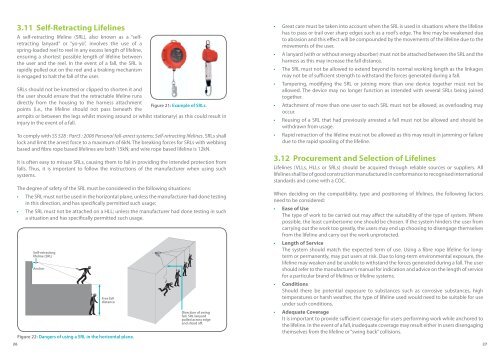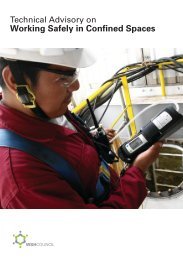HERE - Workplace Safety and Health Council
HERE - Workplace Safety and Health Council
HERE - Workplace Safety and Health Council
You also want an ePaper? Increase the reach of your titles
YUMPU automatically turns print PDFs into web optimized ePapers that Google loves.
3.11 Self-Retracting LifelinesA self-retracting lifeline (SRL), also known as a “selfretractinglanyard” or “yo-yo”, involves the use of aspring-loaded reel to reel in any excess length of lifeline,ensuring a shortest possible length of lifeline betweenthe user <strong>and</strong> the reel. In the event of a fall, the SRL israpidly pulled out on the reel <strong>and</strong> a braking mechanismis engaged to halt the fall of the user.SRLs should not be knotted or clipped to shorten it <strong>and</strong>the user should ensure that the retractable lifeline runsdirectly from the housing to the harness attachmentFigure 21: Example of SRLs.points (i.e., the lifeline should not pass beneath thearmpits or between the legs whilst moving around or whilst stationary) as this could result ininjury in the event of a fall.To comply with SS 528 : Part3 : 2006 Personal fall-arrest systems: Self-retracting lifelines, SRLs shalllock <strong>and</strong> limit the arrest force to a maximum of 6kN. The breaking forces for SRLs with webbingbased <strong>and</strong> fibre rope based lifelines are both 15kN; <strong>and</strong> wire rope based lifeline is 12kN.It is often easy to misuse SRLs, causing them to fail in providing the intended protection fromfalls. Thus, it is important to follow the instructions of the manufacturer when using suchsystems.The degree of safety of the SRL must be considered in the following situations:• The SRL must not be used in the horizontal plane, unless the manufacturer had done testingin this direction, <strong>and</strong> has specifically permitted such usage;• The SRL must not be attached on a HLL; unless the manufacturer had done testing in sucha situation <strong>and</strong> has specifically permitted such usage.Self-retractinglifeline (SRL)AnchorFree falldistanceFigure 22: Dangers of using a SRL in the horizontal plane.Direction of swingfall. SRL lanyardpulled across edge<strong>and</strong> sliced off.• Great care must be taken into account when the SRL is used in situations where the lifelinehas to pass or trail over sharp edges such as a roof’s edge. The line may be weakened dueto abrasion <strong>and</strong> this effect will be compounded by the movements of the lifeline due to themovements of the user.• A lanyard (with or without energy absorber) must not be attached between the SRL <strong>and</strong> theharness as this may increase the fall distance.• The SRL must not be allowed to extend beyond its normal working length as the linkagesmay not be of sufficient strength to withst<strong>and</strong> the forces generated during a fall.• Tampering, modifying the SRL or joining more than one device together must not beallowed. The device may no longer function as intended with several SRLs being joinedtogether.• Attachment of more than one user to each SRL must not be allowed, as overloading mayoccur.• Reusing of a SRL that had previously arrested a fall must not be allowed <strong>and</strong> should bewithdrawn from usage.• Rapid retraction of the lifeline must not be allowed as this may result in jamming or failuredue to the rapid spooling of the lifeline.3.12 Procurement <strong>and</strong> Selection of LifelinesLifelines (VLLs, HLLs or SRLs) should be acquired through reliable sources or suppliers. Alllifelines shall be of good construction manufactured in conformance to recognised internationalst<strong>and</strong>ards <strong>and</strong> come with a COC.When deciding on the compatibility, type <strong>and</strong> positioning of lifelines, the following factorsneed to be considered:• Ease of UseThe type of work to be carried out may affect the suitability of the type of system. Wherepossible, the least cumbersome one should be chosen. If the system hinders the user fromcarrying out the work too greatly, the users may end up choosing to disengage themselvesfrom the lifeline <strong>and</strong> carry out the work unprotected.• Length of ServiceThe system should match the expected term of use. Using a fibre rope lifeline for longtermor permanently, may put users at risk. Due to long-term environmental exposure, thelifeline may weaken <strong>and</strong> be unable to withst<strong>and</strong> the forces generated during a fall. The usershould refer to the manufacturer’s manual for indication <strong>and</strong> advice on the length of servicefor a particular br<strong>and</strong> of lifelines or lifeline systems.• ConditionsShould there be potential exposure to substances such as corrosive substances, hightemperatures or harsh weather, the type of lifeline used would need to be suitable for useunder such conditions.• Adequate CoverageIt is important to provide sufficient coverage for users performing work while anchored tothe lifeline. In the event of a fall, inadequate coverage may result either in users disengagingthemselves from the lifeline or “swing back” collisions.26 27
















